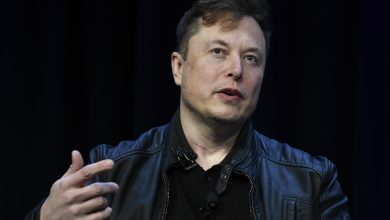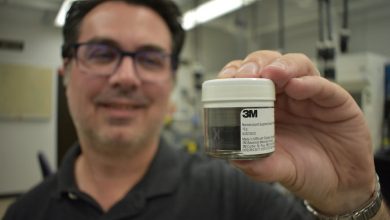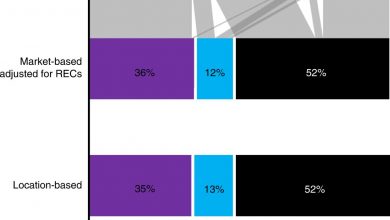In the search for the lithium that will power our future, these three women see a bigger lesson

Three women trek into the barren Nevada desert, boots crunching down a wash until one of them stops at an overhang, pulls out a geology pick, and chips away a chunk of rock.
Over the next few minutes, and during hours of interviews, they explain the relationship between this stone and the battery that powers your electric car.
They talk about prehistoric volcanoes, subterranean brine lakes, advanced technology and the mineral that is changing the future of our planet.
Lithium.
This curiosity of the periodic table is an element so sensitive it can’t be found alone in nature. The pure white metal, when exposed to air, promptly oxidizes and turns black.
Since discovery in 1817, the lightest metal on earth has been used for everything from treatment of bipolar disorder to manufacturing thermonuclear devices.
It’s a metal, a drug and a power source.
Some call it “white gold,” or “the new gasoline,” because it has emerged as the favored battery energizer for today’s electric vehicles, plus almost anything that plugs in.
Amid surging oil prices and the growing climate consequences of fossil-fuel pollution, the market has boomed, sending lithium prices up almost 500 percent in a year—triggering a global race to find and extract mother lodes.
And—eureka!—the substance is right here in Nevada, hundreds of feet beneath a remote desert only jackalopes could love.
Lithium is sold commercially as a compound, either hydroxide or carbonate. Nearly all the commercial product today comes from hard-rock mines. But the world’s largest reserves by far are in underground lakes like those in this place called Clayton Valley.
Which explains why these three women are here in central Nevada.
Mary Little is a geologist-turned-business-executive. As director of Pure Energy Minerals, she oversees the largest number of mining claims in Clayton Valley, if only she can secure rights to pump the water.
Emily Hersh is an exploration entrepreneur. As CEO at Luna Lithium, a start-up company, she has mining claims about 30 miles to the north, if only she can get the permits, cover the costs and find a way to commercially separate the element from brine.
LeeAnn Munk is a professor of geology and geochemistry who does research around the world, including projects for Pure Energy, Luna Lithium and Albemarle Corporation, an international mining giant that claims all water rights in Clayton Valley.
These three women have pioneered new pieces of the lithium energy puzzle, and here amid the stunted Joshua trees, they have plenty to say about their work.
Their story is a struggle worthy of the old West. Tangling with bureaucrats for mining permits. Human ingenuity that conjures metal from brine. A battle with a land baron over another substance that has always—in this desert—been as precious as gold: water.
The members of this trio also have something to say about an industry dominated by men—and about the future of power.
Emily Hersh
Hersh’s pickup truck turns on a single-track road heading into a broad, crusted flat.
August monsoon storms have muddied the way and, about three-quarters of a mile in, the road becomes a quagmire. Forced to retreat with no turn-around, Hersh throws the truck into reverse and drives the entire distance backward.
The incident is metaphorical.
Hersh grew up in Washington, D.C., and after high school headed to Tulane University for an engineering degree—until Hurricane Katrina hit New Orleans, and the engineering school got shut down.
Hersh, 36, said Luna Lithium started work two years ago, has completed geophysical studies and drilled one bore hole at a cost of a million bucks. Water and core samples are promising, but costs and challenges are daunting. She says it’s more of a “caper than a straightforward process. … It takes patience and persistence.” Hersh switched to a double major in political autonomy and economics, focusing on how religion effected world financial conditions. In 2008, she added a masters from American University, with focus on Islam, banking and oil in the Middle East.
She was poised for a career with an organization like the State Department or International Monetary Fund, but instead headed to Argentina.
Soon, she had a consulting business in Buenos Aires, helping oil and gas companies deal with government regulations and logistics. That led to gold exploration in Paraguay, and Hersh became hooked on the hunt.
At first, she was after precious metals. But her base was in the “Lithium Triangle”—Argentina, Chile and Bolivia—and she began to dream of shifting the world energy paradigm away from gas and oil.
Hersh said part of the allure was a grand adventure—pursuing a mysterious resource with uncertainty about where to find it, how to extract it and how the supply chain works. She turned to geologists and market analysts for answers, but found confusion.
“When really smart people disagree about something,” Hersh said, flashing a grin, “that’s opportunity… I want to make discoveries.”
That was half the motivation, Hersh added. The other half: “Unlike gold, lithium is useful… It’s not something you acquire and hide in a basement.”
She found work as an advisor to lithium exploration companies, investors and government agencies while hosting a podcast called the Minerals Manhattan Project.
Part of the spiel is a warning that China is cornering the world market on lithium: “Unless the United States does something in a coordinated fashion,” she said, “we’re all going to be driving cars with Chinese batteries.”
“I don’t think China is beating us because they’re cheating,” she added. “They’re just doing a good job. They have a plan.”
America, she laments, does not: The United States has no mining czar like other nations. Its mineral extraction laws date to the 1800s. Government agencies that handle permits are understaffed, untrained and don’t coordinate with one another.
In her view, Americans crave computers and airplanes and electric cars, but they demonize industries that produce the raw materials.
It’s a view that fits her industry.
At an international lithium conference in Phoenix in June, investors, prospectors and mining executives waxed euphoric about the future of electric vehicles (and the potential to get rich) even as they bemoaned regulatory hurdles to mining.
One speaker compared the potential impact of lithium-ion batteries to the industrial revolution. Another said the effort to meet lithium demand is “like building a spaceship on the launchpad—while you’re launching.”
Over breakfast at the convention, Hersh had talked about her matriculation through the mining industry’s “school of hard knocks” for women.
Misogyny reveals itself mostly in small ways, she said: It’s someone assuming a male assistant is the CEO and she’s the secretary; or getting treated dismissively in a discussion of finances.
“We live in a society that doesn’t support women in positions of power or positions of intelligence,” she said. “I’m constantly having to defend my existence.”
“It wears you down, and it’s hurtful,” she added. “I will stand up to micro- and macro-aggressions, but with a goal that it will happen to fewer other people… I’m good at what I do, and people who back me don’t do it because of or in spite of my in-your-face feminism.”
Mary Little
Raised in Virginia, Little said she knew as a child she wanted to be a scientist, and her parents didn’t distinguish in their expectations for her and two brothers.
She loved chemistry and physics, especially envisioning complex systems in three dimensions. She planned to get a doctoral degree but became fascinated with using core samples and seismic data to figure out where valuable ore might be hiding.
“It was just a lightbulb that went off,” Little said. “And, at the time, it wasn’t lithium—it was copper.”
After working on an exploration job in Michigan, Little wound up getting hired by Atlantic Richfield for a dream job in Chile.
Little was the first woman hired in the domestic metals section, but doesn’t talk about sexism the way Hersh does, saying only, “I had problems, particularly in the first years. … You always make choices. I wouldn’t change anything.”
She spent 15 years in South America chasing copper and gold.
Around 2014, she switched her attention to lithium. “It was never about the money,” Little said. “There were real problems that needed to be solved… The magic is what’s happening now in our industry, and how it’s going to affect lives.”
Little was invited to join the board of Pure Energy Minerals, which she saw as an emerging leader in lithium extraction from brine. The company secured 950 claims in Clayton Valley.
By 2018, bore samples and test wells had verified heavy concentrations of lithium at multiple depths on Pure Energy’s claims.
But that’s where the fight with the land baron comes in.
Albermarle Corp., based in North Carolina, operates a lithium project called Silver Peak. It’s the only commercially producing lithium brine project in North America. It sits in Clayton Valley, right in the middle of Pure Energy’s claims. And Albemarle extracts lithium from the briny water in the classic fashion: It lets the water evaporate.
The brine-pumping method used by Albemarle expends huge volumes of water, requires a year to 18 months for evaporation.
Pure Energy began working with companies on direct lithium extraction, a new process to glean the mineral from water without the delays and ecological impact of evaporation ponds, and then pump most of the water directly back into the ground.
Pure Energy, contends its technique recovers lithium in hours rather than months.
Little, who became Pure Energy’s lead director, said development has been slowed by COVID-19 and regulatory delays. The brine-mining boom in Clayton Valley created manpower shortages and competition for equipment.
But there’s an even bigger catch: Pure Energy has only secured a permit to pump 50 acre-feet of water annually—enough for a test plant, but not commercial production.
More than a half-century ago, long before Albemarle acquired the site, Nevada’s state engineering office calculated the annual water capacity in Clayton Valley at 20,000 acre feet. And every drop was granted in permits to Albemarle’s predecessor.
Today, at least 20 companies boast claims in the basin. Pure Energy is among those to legally challenge the allotment, triggering a modern-day version of the range war only with lawyers instead of gunfighters.
“It is skullduggery,” said Warren Stanyer, president of Nevada Sunrise, which spent years in an unsuccessful bid to wrestle away some of Albemarle’s brine rights. “Mark Twain said, ‘Whiskey’s for drinking, but water’s for fightin’ over…’ It’s a war.”
Little declined to talk about the legal issues, but in 2019 her company protested when the state engineer renewed Albemarle’s water permit.
Pure Energy contended that the engineer’s office was being used “as a pawn to maintain a monopoly,” adding that “Albemarle’s sole purpose of continuing to hold water that it cannot and will not use is economic warfare—if no other companies can access water rights in Clayton Valley then Albemarle will be able to continue its reign as the only producing lithium mine in Nevada.”
Albemarle, in response to questions about its mining operations, wrote in a statement that is has “been going through the process of proving up full beneficial use” of its water rights. “Unfortunately, that process has been slowed by tactics and allegations from other parties looking to obtain rights to that same water,” the company said.
It said the aquifer water in the Silver Peak area is already highly salty—four times as salty as seawater—thus the presence of lithium. “These brine aquifers are not able to be used for drinking water, agricultural, or irrigation water.” While the site also taps an uphill freshwater source, the company said, “approximately 97.5% of the groundwater usage at Silver Peak is brine.”
Albemarle’s president of the lithium business unit, Eric Norris, recently announced major expansion plans that would double production and use all of the valley’s water allotment.
Little shook her head at that prediction. “Well, they’ve said that, but they haven’t done it,” she noted. “And there’s room for multiple players to win with brine.”
Leeann Munk
Wild horses trotted up to a desert a hot spring in a corner of Clayton Valley as Munk launched an impromptu seminar on volcanic cinders and calcium carbonate mounds.
Some of the exposed rocks are intrusives dating back 600 million years. Geothermal water was forced through fissures to the surface. As the planet warmed and cooled over eons, rain cycles filled and dried the playa repeatedly, leaching minerals each time.
Now, except for the hot spring, the only surface water is in Albemarle’s nearby evaporation ponds.
Munk, the daughter of a hairdresser and a sheet-metal worker in northern Michigan, said she enrolled in a college geology class by accident because it fit her schedule. A field trip got her hooked on the campfires, adventure and outdoor quest. Then she discovered the magic of chemistry and blended two disciplines, focusing on interactions between water and rocks.
From a base at the University of Alaska, Anchorage, Munk got intrigued by lithium more than a decade ago. It was this weird element just beyond hydrogen and helium on the Periodic Table. It also was an unexplored mineral, she said, “wide open to discoveries.”
Today, when someone asks Munk what she does for a living, the answer is simple: “I help find the world’s supply of lithium.”
That job definition brought her together with Hersh and Little. All three worked in South America, and they forged a friendship in part because there are so few women in geology.
“Every time you’re in a room, you’re the one person,” Munk said. “It’s pretty obvious to the world that women in engineering and math fields are outnumbered and starting on a lower rung of the ladder. That’s part of being who I am.”
But the relationship also stems from a common mission, Munk said: pursuing a commodity that will thwart climate change while delivering power to economically deprived communities.
“The common thing is, we’re all working to advance lithium and help the world,” said Munk, who also studies the loss of glacial ice in the Arctic and Antarctica. “It’s a place I never imagined myself… The more pioneering and out there it is, the more I love it.”
A spontaneous discussion
Driving through Clayton Valley, the women stop on an overlook and launch into a philosophical discussion of mining history, economics and ethics.
Munk holds up her cell phone and laments the rabid anti-mining sentiment of Americans who walk around with lithium batteries in their purses and pockets. “It’s hypocrisy,” she says. “You can’t have it both ways,” she says.
Hersh joins in, saying the public demonization of mining is “almost like a fetishism.”
They continue grumbling about environmental laws and government oversight until someone mentions that, historically, unregulated mining savaged public lands with open-pit scars and toxic waste. Yes, they agree, and it wasn’t just ecological devastation, but colonial enslavement and exploitation of workers for centuries.
But that was in the past, when companies had a single-minded mission to make money “and all else be damned,” Munk says.
Today, Hersh adds, the No. 1 objective is not profitability, but social justice: Calculating the overall positives and negatives of a project not just for shareholders, but for the local and global community.
For example, Munk says, mining brings roads, electricity and jobs to remote villages while supplying minerals to the world. “If we all put our minds together and have a vision,” she adds, “we can make things change in a better way.”
The implication is that women are part of that change. But how? Whether geologists and CEOs are male or female, there will always be conflicts between earnings, labor costs and environmental protections.
“It’s an impossible set of ever-changing values and variables,” Hersh decides, “and the job of leaders is to measure and juggle them, issue by issue and point by point.”
Even with lithium, Little says, the values can be murky. Yes, battery-powered cars will dramatically reduce carbon emissions. But brine extraction projects will use chemicals, consume water, produce waste. And the batteries still require electricity for re-charging.
“There are always trade-offs,” she allows. “It’s not 100 percent free.”
Conclusion: So above is the In the search for the lithium that will power our future, these three women see a bigger lesson article. Hopefully with this article you can help you in life, always follow and read our good articles on the website: Ngoinhanho101.com





